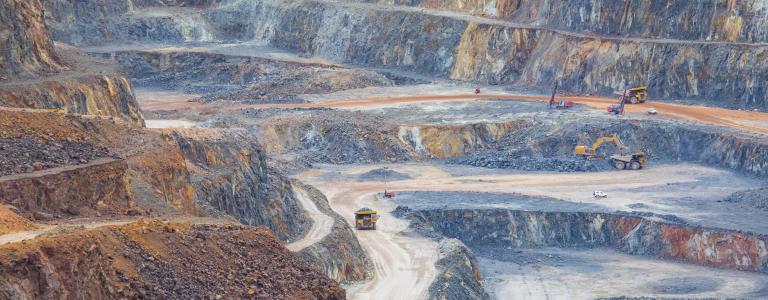Net-Zero Should Not Be a Net Loss for Low-Income Economies
As countries make the transition towards net-zero economies, what do these policies mean for international trade?
Climate change policies have taken on many forms, including much-needed net-zero commitments, green new deals, and circular economy plans. Together, the economies of countries that already have, or intend to have, net-zero targets account for 68% of global GDP and 56% of the global population.
Net-zero and circular economy policies are new and must quickly move from being aspirational to actionable. But as these policies are implemented, they will impact international trade and, according to a new IISD report, influence the development of lower-income economies.
When we take a snapshot of developing country exports, we see that resource exports are the most important when looking at their share of that country’s revenue. In sub-Saharan Africa, fossil fuel exports accounted for USD 146 billion of the region’s revenue in 2018, whereas the export of metals and minerals accounted for USD 110 billion. To put this in perspective, agricultural exports accounted for USD 48 billion in revenue. Most of these fossil fuel exports go to countries with net-zero targets.
The low-carbon energy transition will directly impact demand for key resources. Most net-zero and circular economy plans are predicated on the drastic reduction of oil demand, which means that developing countries might lose out. Oil exports from sub-Saharan Africa, for instance, accounted for 84% of that USD 146 billion in highly valuable revenue 3 years ago.
With tightening markets for crude and refined oil in the short to medium term, it is questionable whether producers in lower-income economies could retain a competitive edge on the international oil market. They are not the lowest-cost producers, nor do they have the subsidy capacity to artificially lower their production cost.
South Sudan, Angola, Nigeria, Chad, and the Republic of the Congo, in particular, rely on fossil fuels for more than 50% of their exports, a share that can soar to 96% in the case of South Sudan. These countries will urgently need to diversify their revenues and exports or risk being detrimentally affected by net-zero commitments and circular economy packages. This requires that they build industrial capacity quickly, given how challenging economic diversification has been in the past.
Critical minerals and the energy transition
While markets for fossil fuels will tighten, there is space for growth when it comes to metals and minerals, notably those essential to the energy transition. These include non-ferrous metals such as copper, aluminum, nickel, and zinc. Some of these materials serve dual purposes: nickel, for example, is used to make lithium-ion batteries but also to produce stainless steel, which is critical in the construction of wind turbines. Copper is a conductor for wind power but equally essential for general wiring and in the manufacturing of electric vehicles.
While markets for fossil fuels will tighten, there is space for growth when it comes to metals and minerals, notably those essential to the energy transition.
The potential growth for these markets is immense. Even if the circularity of key metals is improving, strong increases in demand coupled with challenges of supply (the time needed to develop new projects, export restrictions, rising production costs, social tensions, and climate-related stresses) will require greater investment in mineral-rich countries to accelerate the global energy transition.
Investments in mining projects in developing countries are capital intensive and rely on assumptions about the longevity of resource use. While African countries can be particularly important for producers, given their reserves—especially in platinum, manganese, bauxite, and chromium—there are also a number of concerning indicators that cast doubt on low-income countries being able to fully exploit demand growth.
Already, there is a strong discrepancy between reserves and production, with several developing countries holding a larger percentage of minerals in reserve compared to what they produce. Furthermore, additional political and economic measures would be needed to ensure that export gains reflect positive developmental outcomes.
Why economic diversification matters
The magnitude of the impacts that changes in fossil fuel and metal markets have on developing countries will depend on several factors and variables. These include the extent to which imports can effectively be substituted by cleaner alternatives, such as recycled materials, and the ability of developing countries to diversify their economies and rely on a wider set of exported goods.
Still, because the scale of potential impacts is so significant, governments must plan ahead, while international partners must be ready to provide support. Besides technical assistance and capacity building (for example, under the Aid for Trade initiative), the promotion of intra-African trade in the context of regional integration, including the African Continental Free Trade Area, could support economic diversification.
While sub-Saharan African countries and least-developed countries tend to export a very narrow set of goods to their OECD trading partners and large emerging economies like China, intra-African trade is clearly more diversified and balanced. Regional trade has also grown significantly and consistently since 2002 to become the largest destination of sub-Saharan African countries’ exports. In addition to offering new opportunities for diversification, regional trade is also less likely to attract restrictions related to net-zero commitments or circular economy packages.
In sum, low-income economies that currently rely on fossil fuel exports will, if they do not diversify and adapt, see their export revenue reduced as net-zero and circular economy policies are implemented. On the other hand, the clean energy transition also offers opportunities for supplying the market with critical metals and minerals, which are often found in low-income countries. While the net effect will depend on the good and country in question, encouraging South¬–South regional trade flows can help all countries diversify their export revenue and reduce reliance on resource exports.
Funded by
You might also be interested in
Une course aux subventions aux armements s’engage entre l’Europe et l’Amérique (in French)
Lorsque le président américain Joe Biden a promulgué la loi sur la réduction de l’inflation, il a promulgué le plus grand investissement climatique de l’histoire américaine – un moment historique pour une nation qui pompe plus de carbone dans l’atmosphère que n’importe quel pays à l’exception de la Chine.
Canada’s biggest emitters are paying the lowest carbon tax rate
On its oil sands in northern Alberta, Suncor Energy scrapes vast open-pit mines and drills down deep into the ground to extract the viscous bitumen that has turned it into one of the largest energy companies in North America. The process is so energy-intensive that it has also made the firm into Canada’s largest carbon emitter: it belches roughly 28 million tonnes into the atmosphere every year, equivalent to the entire emissions of Tunisia.
Border Carbon Adjustments: Priorities for international cooperation
This IISD policy brief looks into border carbon adjustment design elements that are priorities for international cooperation, as well as the possible venues, formats, and shapes that such a discussion might take.
Border Carbon Adjustments: Pivotal design choices for policy-makers
This policy brief covers the pivotal choices in the design of border carbon adjustments, aiming to provide useful insights to policy-makers and set the ground for the broader discussions about the best practices.

